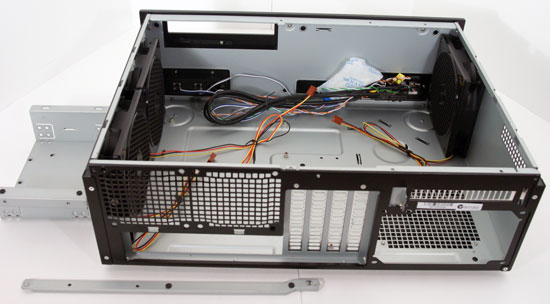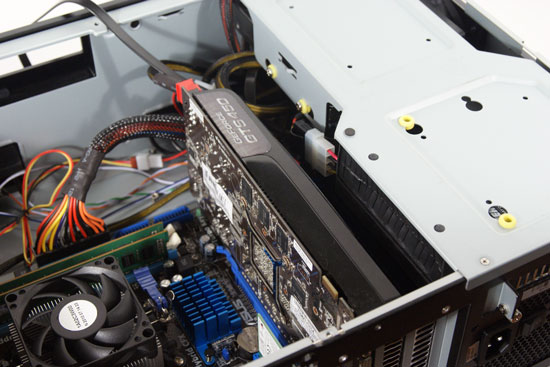SilverStone GD04 HTPC Case: Cool, Not Quiet
by Dustin Sklavos on December 25, 2010 12:00 AM EST- Posted in
- Cases/Cooling/PSUs
- HTPC
- SilverStone
- GD04
Assembling an HPTC in the GD04
When building in most cases, the assembly is fairly self-explanatory. The SilverStone GD04? Not so much. Installing my hardware in the GD04 actually resulted in my consulting the instructions that come with the case fairly frequently, and there's a reason why: SilverStone specifies a very specific order for installing components to keep cable routing fairly clean and easy.

The first thing you'll need to do is remove the trays and the crossbar, and for sanity's sake the motherboard should probably go in before the power supply does. SilverStone actually includes rubber standoffs that adhere to the bottom of the power supply, as there's a centimeter or so worth of empty space between where the unit mounts and the bottom of the case. You'll want to connect whatever cables you can and install your expansion cards, because the next step involves putting the crossbar back in.
It's at this point that you should also note the 120mm fans all come with three-pin connectors and are intended to be plugged into and controlled by the motherboard. That would be fine, but most MicroATX boards don't come with that many fan control headers (to say nothing of MiniITX), not to mention how mediocre most motherboard implementations of fan control are. SilverStone includes an adapter that allows you to plug all three headers into a single molex connector, but that also means the fans are running at full bore all the time, and you'll see why that's a problem later on. Mercifully, the fans have built-in internal grates that keep bunched up cables from getting caught in the fan blades.
After you've replaced the crossbar, you'll need to mount the hard drive or drives into the mounting tray. The tray actually supports up to three drives total: two 3.25" and a 2.5". It's probably easiest to just install one big storage drive - this is a media center case after all. The 2.5" bay does make using an SSD as an OS drive easy, however. Installing the optical drive is also pretty simple, and there's some give on it so you can line it up properly with the opening in the front. I've read that one or two users on NewEgg had to shave off part of the tray opening for their builds, but the combination Blu-ray/HD-DVD drive I have fit perfectly and without issue.

If you follow the instructions that come with the GD04, assembly actually goes fairly smoothly. The main problem is really just what a nuisance all the tiny screws can be. I understand going entirely toolless may be a convenience not available for a case this size designed for this task, but I can't help but feel like this whole ordeal could've been easier.
















68 Comments
View All Comments
asgallant - Saturday, December 25, 2010 - link
I recently built an HTPC based on the GD05, and with a low-power CPU (the Athlon II X3 415e, stock cooling) at it's center, the system is barely audible from ~1 meter away, nevermind sitting ~15 feet away from the couch. The only noise issue the system has is the Blu-Ray drive, which makes a racket when it spins up to full speed. Vibration dampers would help here, but even with them, it would still be an unpleasantly loud noise source. Aside from the lack of vibration dampers on the ODD tray, the only problem I have with this case is that it doesn't have a built in infrared port for remote controls.mcveigh - Saturday, December 25, 2010 - link
I agree with some of the other posters. The sound testing should have identified what components were noisy...not just this particular configuration is loud.maybe try other video cards, and power supply's. I'd love to see testing with fanless video cards and power supply's so we can compare the changes.
I'd love to see more HTPC case testing! Well Done!
Drizzt321 - Saturday, December 25, 2010 - link
I don't mean to nitpick...but I am. Last page, 2nd paragraph, 1st sentence, the word 'confern' I think was meant to be 'concern'.Beenthere - Saturday, December 25, 2010 - link
Silverstone products are considered mainstream not high end quality. You generally get what you pay for in life. I'd skip Silverstone products if I was looking for quality.micksh - Sunday, December 26, 2010 - link
They are generally better than Thermalfake or Moneual for example. Zalman, Lian-Li are too overpriced, I think. Lian-Li cases also look like soulless boxes with no identity.In fact, I believe Silverstone makes well designed products.
So, what do you typically buy for your HTPC, that $1200 OrigenAE S21T case?
MeanBruce - Sunday, December 26, 2010 - link
Again agreeing with Micksh, the Lian-Li’s although very well built all look alike to me and there are so many of them, it’s like going to a paint store and deciding over 85 shades of blue, how could you possibly choose? Don’t know why they have to produce 200 different black boxes that are mostly indistinguishable. My last build I could have spent up to $700 on a case as I even considered that Thermaltake Level 11/BMW design thing, but I didn’t want a 40pound case or a full tower since I only run one video card, I needed the smallest case that could still house a full ATX mainboard, and this new size that many companies are producing the “midi” tower is perfect. Bitfenix Survivor, Fractal Design’s new Arc case, Lian Li also makes a midi LanCool brand, and Cooler Master 912 Advanced. I settled on the Cooler Master, it really is the most complete and feature laden case of the four. Bitfenix is not selling in the US yet but next year they will have a Survivor with full mesh panels, which will make a great silent pc. There seems to be two approaches to a silent build, noisy components, closed case design and soundproofing, Or the one I like, ultra quiet components, and open case design with lots of ventilation and moving large amounts of air quietly. I don’t agree with this mainstream vs high- end argument, it really should be the case that is perfect for your needs, at $99dollars the 912 Advanced may seem mainstream or even budget to some, but the design and quality are amazing, so whether its mainstream or high-end who cares as long as it’s just right for the build. Also I went through that Zalman phase, didn’t we all, CPU cooler, VPU cooler, PSU, they were the quietest at the time, but now it’s Noctua, I run the extra-large NH-D14 CPU heatsink with no fans at all, it’s that good. VPU heatsink, the Prolimatech MK-13 is the current silent leader, but it’s also Huge, taking up 4slots with a fan attached, so not for a multicard set-up. Micksh seems to know what he is doing, let me know if you need any info I have.This may not have been an article on creating a silent pc, but the discussion definitely turned into one, and that’s why we all come here, to find out what works, what doesn’t, and what works extremely well. There are a few products out there that fall into the latter category and they truly should not be missed.
Jhatfie - Saturday, December 25, 2010 - link
I have the GD04 as my HTPC with a Phenom II X2 555 unlocked to a 955 @ 3.6Ghz and a XFX 5850 using and you can barely hear the thing even when under heavy load gaming. My xbox 360S is easily twice as loud.For $99 this is a excellent case. Clean design, plenty of room for full size graphics cards, good cooling that blows away other HTPC cases I tried. CPU dropped 10C alone under load over the prior case I was using. Layout is good, only real negative I have is the lack of cable management.
londiste - Sunday, December 26, 2010 - link
i have not seen a built-for-purpose htpc case (not even an extremely expensive one) that was easy to build a computer in. reviewer says almost the same thing at the top of the page and at the end of page complain about the complexity?complaints about long power supplies seem a bit arbitrary, i can't imagine an htpc that would warrant a 700+w power supply while being even remotely silent enough to fill the role.
sorry but the components of your choice are loud. i understand that you picked what was laying around but if you put silence as paramount as you say, you should know better than to use components like that. if you need/want amd, at least go for energy efficient models (605e/615e work wonders with power usage/heat and thus, noise).
getting as little heat as possible is even more important in a case like this - while there is a general scheme for airflow, it is far from optimal and i would not count on heat getting out of this case easily. a delta of 40c (cpu/gpu) for idle/load seems to confirm that.
as already commented, noise number do not say much in this way. how much was contributed by case fans and how much by cpu/video cooler, psu fan? was what the noise floor? you did mention a fan controller in the article - did you have/get one and try to slow down the fans, did it help, were the temperatures still reasonable?
i see from comments that the noise questions have been downplayed as not that important but i do not believe that is the case. reviewer clearly states silence as a goal and htpc as an entire category has low noise as one key aspect.
while it is not new and it has been said in this article's comments as well - tolerable noise level is a very subjective thing. just an example - i had to replace zalman cnps9500 (at minimum rpm with fanmate) as it was much noisier than anything else in my computer. now i can hear the corsair hx520 fan at idle (using 100-120w, psu stats state ~16dba).
justaviking - Sunday, December 26, 2010 - link
Dustin,Writing for Anandtech might be like going to the Olympics. The standards of excellence are extremely high. You are not judged against average writers, but the against very best.
Some of the comments are, I think, very valid feedback. Use it to make your next article stronger. Not only are the Anandtech writers the best, so are their readers. Reader feedback here is often better than other people's articles.
My $0.02 is I would like to see and apples-to-apples comparison. Use the same components in two cases. Then you could compare the audio levels, and adding some subjective comments would put the numbers into context. (You should include your background noise levels too.)
Thanks again. Hang in there. Use the feedback to get stronger. And lastly, Merry Christmas and Happy New Year.
micksh - Sunday, December 26, 2010 - link
Yes, that's what I tried to achieve with my comments - make next articles stronger.Finding information about quiet HTPC build is difficult and I would appreciate if Anandtech becomes a good source of information in this area (as excellent as it is in other areas).
I hope authors disregard parts of comments that sound too emotional (I know I could have been more polite, I'm sorry if I sounded inappropriate). But I also hope they will use information parts of the feedback for next articles. Looking forward to see follow up, Dustin.